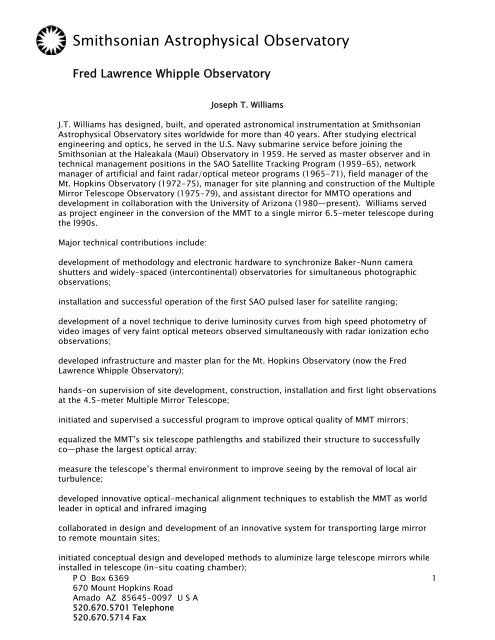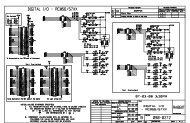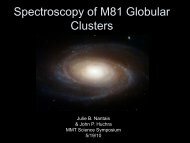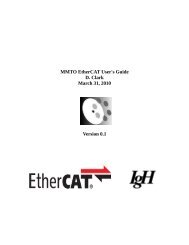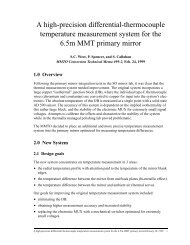Smithsonian Astrophysical Observatory - The MMT Observatory
Smithsonian Astrophysical Observatory - The MMT Observatory
Smithsonian Astrophysical Observatory - The MMT Observatory
Create successful ePaper yourself
Turn your PDF publications into a flip-book with our unique Google optimized e-Paper software.
<strong>Smithsonian</strong> <strong>Astrophysical</strong> <strong>Observatory</strong><br />
Fred Lawrence Whipple <strong>Observatory</strong><br />
Joseph T. Williams<br />
J.T. Williams has designed, built, and operated astronomical instrumentation at <strong>Smithsonian</strong><br />
<strong>Astrophysical</strong> <strong>Observatory</strong> sites worldwide for more than 40 years. After studying electrical<br />
engineering and optics, he served in the U.S. Navy submarine service before joining the<br />
<strong>Smithsonian</strong> at the Haleakala (Maui) <strong>Observatory</strong> in 1959. He served as master observer and in<br />
technical management positions in the SAO Satellite Tracking Program (1959-65), network<br />
manager of artificial and faint radar/optical meteor programs (1965-71), field manager of the<br />
Mt. Hopkins <strong>Observatory</strong> (1972-75), manager for site planning and construction of the Multiple<br />
Mirror Telescope <strong>Observatory</strong> (1975-79), and assistant director for <strong>MMT</strong>O operations and<br />
development in collaboration with the University of Arizona (1980—present). Williams served<br />
as project engineer in the conversion of the <strong>MMT</strong> to a single mirror 6.5-meter telescope during<br />
the l990s.<br />
Major technical contributions include:<br />
development of methodology and electronic hardware to synchronize Baker-Nunn camera<br />
shutters and widely-spaced (intercontinental) observatories for simultaneous photographic<br />
observations;<br />
installation and successful operation of the first SAO pulsed laser for satellite ranging;<br />
development of a novel technique to derive luminosity curves from high speed photometry of<br />
video images of very faint optical meteors observed simultaneously with radar ionization echo<br />
observations;<br />
developed infrastructure and master plan for the Mt. Hopkins <strong>Observatory</strong> (now the Fred<br />
Lawrence Whipple <strong>Observatory</strong>);<br />
hands-on supervision of site development, construction, installation and first light observations<br />
at the 4.5-meter Multiple Mirror Telescope;<br />
initiated and supervised a successful program to improve optical quality of <strong>MMT</strong> mirrors;<br />
equalized the <strong>MMT</strong>’s six telescope pathlengths and stabilized their structure to successfully<br />
co—phase the largest optical array;<br />
measure the telescope’s thermal environment to improve seeing by the removal of local air<br />
turbulence;<br />
developed innovative optical-mechanical alignment techniques to establish the <strong>MMT</strong> as world<br />
leader in optical and infrared imaging<br />
collaborated in design and development of an innovative system for transporting large mirror<br />
to remote mountain sites;<br />
initiated conceptual design and developed methods to aluminize large telescope mirrors while<br />
installed in telescope (in-situ coating chamber);<br />
P O Box 6369<br />
670 Mount Hopkins Road<br />
Amado AZ 85645-0097 U S A<br />
520.670.5701 Telephone<br />
520.670.5714 Fax<br />
1
<strong>Smithsonian</strong> <strong>Astrophysical</strong> <strong>Observatory</strong><br />
Fred Lawrence Whipple <strong>Observatory</strong><br />
consulted with and supervised on-site assembly of the Large Binocular Telescope structure and<br />
installation of primary mirrors,<br />
and served as interim director of <strong>MMT</strong> <strong>Observatory</strong> May 2004-November 2005.<br />
Williams is considered expert in the siting and optimization of imaging performance in large<br />
optical—infrared telescopes. Since 1984, he has traveled to major observatories in western<br />
countries and Russia with thermal and infrared imaging equipment to identify and remedy<br />
thermal sources degrading large telescope ‘seeing” and image quality.<br />
http://www.mmto.org/mmtconv_pix/themove/a13.jpg<br />
J.T. Williams checks the 6.5-meter <strong>MMT</strong> primary mirror before its trip up the single-lane<br />
mountain road to the Mt. Hopkins summit. Bill Omann controls the trailer’s counterweight<br />
system.<br />
---<br />
http://www.mmto.org/mmtconv_pix/themove/b12.jpg<br />
J.T. Williams, at right, guiding 6.5-meter mirror load up final 26% grade to Mt. Hopkins summit.<br />
http://www.mmto.org/mmtconv_pix/primaryin/a32.jpg<br />
J.T. Williams on center guide rope as the 6.5-meter <strong>MMT</strong> primary mirror is lowered into the<br />
telescope.<br />
http://www.mmto.org/mmtconv_pix/primaryin/b17.jpg<br />
J.T. brings the mirror down the last few millimeters on the Hydroset.<br />
-----------------------------------------------------------------<br />
http://medusa.as.arizona.edu/lbto/news/uanews_press_release.htm<br />
J.T. Williams inspected Mt. Graham road on foot prior to transport of first 8.4-meter mirror.<br />
http://medusa.as.arizona.edu/lbto/march05/040301ac.JPG<br />
J.T. Williams cleaning surface of LBT 8.4-meter primary mirror.<br />
P O Box 6369<br />
670 Mount Hopkins Road<br />
Amado AZ 85645-0097 U S A<br />
520.670.5701 Telephone<br />
520.670.5714 Fax<br />
2
<strong>Smithsonian</strong> <strong>Astrophysical</strong> <strong>Observatory</strong><br />
Fred Lawrence Whipple <strong>Observatory</strong><br />
J.T. Williams<br />
(<strong>MMT</strong>O photo by B. Russ)<br />
P O Box 6369<br />
670 Mount Hopkins Road<br />
Amado AZ 85645-0097 U S A<br />
520.670.5701 Telephone<br />
520.670.5714 Fax<br />
3


